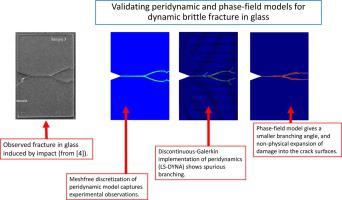当前位置:
X-MOL 学术
›
Eng. Fract. Mech.
›
论文详情
Our official English website, www.x-mol.net, welcomes your
feedback! (Note: you will need to create a separate account there.)
On validating peridynamic models and a phase-field model for dynamic brittle fracture in glass
Engineering Fracture Mechanics ( IF 4.7 ) Pub Date : 2020-12-01 , DOI: 10.1016/j.engfracmech.2020.107355 Javad Mehrmashhadi , Mohammadreza Bahadori , Florin Bobaru
Engineering Fracture Mechanics ( IF 4.7 ) Pub Date : 2020-12-01 , DOI: 10.1016/j.engfracmech.2020.107355 Javad Mehrmashhadi , Mohammadreza Bahadori , Florin Bobaru

|
Abstract We test two peridynamic models and one phase field model against recent experimental tests on dynamic fracture/crack branching in glass induced by impact. We find important differences in results among the two peridynamic models (one using the meshfree discretization, the other being the LS-DYNA’s discontinuous-Galerkin implementation) and the phase-field model. We monitor the crack branching location, angle of crack branching, the time-profile of crack propagation speed, and some fine features seen experimentally: small twists/kinks in the crack paths near their end. The results shown here provide guidance in selecting the most appropriate solution method for dynamic brittle fracture in glass and explain likely reasons behind the failure of some of the models to correctly predict the observed behavior.
中文翻译:

关于验证玻璃动态脆性断裂的近场动力学模型和相场模型
摘要 我们测试了两种近场动力学模型和一种相场模型,与最近关于冲击引起的玻璃动态断裂/裂纹分支的实验测试相比较。我们发现两种近场动力学模型(一种使用无网格离散化,另一种是 LS-DYNA 的不连续伽辽金实现)和相场模型之间的结果存在重要差异。我们监测裂纹分支位置、裂纹分支角度、裂纹扩展速度的时间曲线以及一些实验观察到的精细特征:裂纹路径末端附近的小扭曲/扭结。此处显示的结果为选择最合适的玻璃动态脆性断裂求解方法提供了指导,并解释了某些模型无法正确预测观察到的行为背后的可能原因。
更新日期:2020-12-01
中文翻译:

关于验证玻璃动态脆性断裂的近场动力学模型和相场模型
摘要 我们测试了两种近场动力学模型和一种相场模型,与最近关于冲击引起的玻璃动态断裂/裂纹分支的实验测试相比较。我们发现两种近场动力学模型(一种使用无网格离散化,另一种是 LS-DYNA 的不连续伽辽金实现)和相场模型之间的结果存在重要差异。我们监测裂纹分支位置、裂纹分支角度、裂纹扩展速度的时间曲线以及一些实验观察到的精细特征:裂纹路径末端附近的小扭曲/扭结。此处显示的结果为选择最合适的玻璃动态脆性断裂求解方法提供了指导,并解释了某些模型无法正确预测观察到的行为背后的可能原因。











































 京公网安备 11010802027423号
京公网安备 11010802027423号